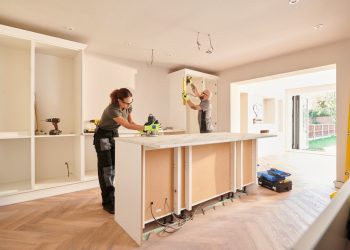There are few events that perplexed the real estate industry as much as Zillow’s exodus from iBuying late last year.
Even now—months after the tech giant announced that it was sunsetting Zillow Offers— discussions about the digital homebuying, cash offers and algorithmic house flipping future are rarely had without mentioning Zillow.
However, another question that has piqued the interest of industry experts and observers is: what’s next for Zillow?
With 2022 in full swing, we spoke with Errol Samuelson, Zillow’s chief industry development officer ahead of its investment call this week, to discuss the tech company’s exit from iBuying and what changes the industry could expect out of its business model in the future.
Jordan Grice: Let’s start out with one of the biggest stories of 2021—the end of Zillow Offers—what can you tell us about the progress of phasing out that operation?
Errol Samuelson: It’s going well. We are in the process of selling the homes that we bought and had offers on at the time that we decided to close down the business.
The underlying goal for Zillow Offers, which was how do you bring more certainty and less friction to the real estate transaction, hasn’t changed. There are a bunch of things that we are doing that focus on that same idea of reducing friction and making moving less stressful.
JG: What are your thoughts on iBuying as a business model, considering how abruptly things ended with Zillow Offers last year?
ES: We learned a couple things from Zillow Offers. One was that for that business to have an impact on enough consumers you couldn’t just be spotting a few thousand homes a month. You had to be buying at scale. The challenge with owning tens of thousands of homes is when you have volatile markets like we had last year, it’s really hard to price. You’ve got to know what the home is going to be worth in three months or six months after you’ve done the renovations and put it back on the market.
Last year, we set a record for home price appreciation—19.6% year-over-year home price appreciation as of December—and it’s crazy. Some markets saw even more, and in those kinds of markets, it’s very hard to predict where prices are going, and that creates all sorts of risks if you can’t price the asset correctly.
I think the more important moral of the story is that we learned that while people would come to our site, and we’d give them a good offer, only about 10% accepted the offer.
JG: What would you say to people who might question Zillow’s credibility since backing out of iBuying?
ES: Zillow has always been focused on innovation and we’ve brought a lot of innovations to the market over the years. I think if you’re going to be an innovator, you have to take risks, and you have to try things.
We had an opportunity and we took a big swing, and when we realized that it wasn’t the opportunity that we thought it was, it also took equal courage to stop doing it. We just came to the decision that this was not a business that was going to scale and help enough consumers and so we stopped doing it.
JG: What is Zillow’s attitude towards getting back into the purchasing or facilitation of homebuying again either through iBuying or another platform like Power Buying?
ER: The way I’d answer that question is to think about the way our buying has been broken down during the journey, which we break down into four pieces.
Piece number one we call “dream and discover,” and in many ways, that’s what Zillow has been doing almost from the beginning. It’s about information transparency, giving consumers what’s on the market or what a home is worth.
Once you’ve found possibilities, how do you find the one, which is phase two. Then, once you’ve found the one, how do you actually make sure you’re the one that gets to buy it and not someone else. Once you have the offer accepted, piece four is how do you close this thing with certainty and speed and the least amount of pain?
When we’re looking at the home journey, we have teams working on those four problems.
JG: How is Zillow addressing these different aspects of the consumer journey?
ES: The problem that we are spending a bunch of time on right now is how do you fix the home-touring problem. We’ve noticed that a lot of times we had a consumer who wanted to go see a home, and couldn’t get in. We went and talked to ShowingTime and they told us that there were 92 million showing requests on our platform last year, but only 68 million of those got fulfilled.
This is a boring problem, and what we are doing is attacking it in three different ways.
The first is a new technology that we call “3D Home” and it’s sort of like your next-generation, virtual tour that allows you to walk through the house. What we found is that homes that have these 3D Home tours are viewed 45% more than homes that don’t have them and on average they sold 14% faster.
Then, we’re putting a bunch of technology, resources and engineering into ShowingTime so that when that buy-side request comes in to see a home in person, we can make sure that the agents can connect and we can get that person into the house. We also just launched a beta test of a product where you can actually use the Zillow app as a mobile control to get into the house.
So with these three different projects that we have going on right now, we are going to try to fix this boring but incredibly impactful problem of getting into a house.
JG: What other innovation can we expect that will help drive the next generation of Zillow and its business model?
ES: There are a bunch of things that we are doing to simply help consumers buy homes. We have a really sophisticated artificial intelligence engine that sits behind our user search interface.
We’re doing essentially the same thing for listings that Netflix does when it sends users a “here is a show that you’re probably going to like” suggestion. On the second time you come back to the app or site, we’ve looked at not only what you’ve been searching, but also what people similar to you are searching; our goal is, on that first page of search results, to get you a house we think you’re going to like. The goal is, you should never have to go to page two to get a home that you like.
Another thing, we just incorporated SharePlay, an Apple FaceTime feature that works with Zillow. What it does is set up a FaceTime call and you and another person can use the app at the same time. In our research, we found that 86% of our users on Zillow said they were shopping with someone else—either a spouse, housemate or parent.
JG: How is Zillow positioning platforms and tools like the recently acquired ShowingTime to fuel the evolution of the Zillow business model?
ES: When we think of some of the software we’re building, it kind of falls into two camps.
One camp is software and features that we build for our advertisers—premier agent customers—and it’s exclusive to them, and that’s to help make them better at their jobs.
The other category of software is platform software. The goal there is to make it available to everybody, and Dotloop and ShowingTime are examples of that. The theory behind the platform pieces of our business is that when the industry works better as a whole, everyone benefits.
We actually think that there would be more movers and transactions if we as an industry could actually reduce the friction.
JG: What other tech and tools are most impactful to Zillow’s goal of streamlining the process for consumers and reducing that friction?
ES: Part of it is that there are some platforms and tools that we think if we buy the business and invest a bunch of engineering and research and development dollars, that we can make the business better.
On the other hand, there are all sorts of tools out there that we think are super important and powerful that work just fine and we don’t need to own them. We have more than 75 different integrations with different pieces of software, so I think that’s the difference, and maybe the decision matrix.
I think the future is anything which today feels offline or clunky is going to be online and is going to be streamlined, including the loan origination process and at some point, appraisals.
JG: What can you tell us about the future of Zillow referrals for real estate agents and the role it will play in the company’s future business model?
ES: We want to help modernize this industry and the only way we can do it is with agents of various brands, brokerages and affiliations. Regardless of what company or franchise brand they are at, they have the same characteristics. They are technically capable, innovative and willing to learn best practices.
The idea of referrals at Zillow is just simply a different billing model. You can buy advertising from us in one of two ways. You can take your credit card and buy up front as an agent and then you bear the risk. The second model—the Zillow Flex model—we send you the leads at no charge, and if you close them, then you pay us at the close of the transaction versus at the beginning of the cycle.
In the flex model, we bear the risk because you didn’t pay up front, but in many ways that does two things. It makes us a better partner because now we are completely invested in your success. It also gives us the incentives to do the things like solve the touring problem and work with the most forward-thinking, tech savvy brokers, teams and agents.
Our goal is to get the agents who are tech savvy and open to change and then partner with them and then make their success and our success co-dependent, and if we can do that, we think that’s a big win for everybody.
JG: What are the most important issues facing your clients in the next six months?
ES: I think it’s simply affordability and inventory shortage. Both are two sides of the same coin. A lot of what is pushing up prices is a shortage of availability. Related to that is this thing that we’ve been seeing—we’re calling it the Great Reshuffling—and basically it kicked off during the pandemic when people just wanted to get out of the city. Or, now that everyone is working from home, working out of a closet didn’t work, so you need an extra room for an office.
There is a different tailwind at the moment and that tailwind is remote work. All of a sudden you’ve got people moving to different neighborhoods, cities and states and I think that is really interesting in terms of what happens to the downtown core in cities.
I think there is a reason Boise is up over 40% because a lot of people are selling their million dollar homes in California and are willing to pay half that in Boise. I think that’s another big trend.
That’s a macro five-year-plus kind of trend and I think we are just at the beginning of it.
 Jordan Grice is an associate online editor at RISMedia. Email him your real estate news ideas to jgrice@rismedia.com
Jordan Grice is an associate online editor at RISMedia. Email him your real estate news ideas to jgrice@rismedia.com












